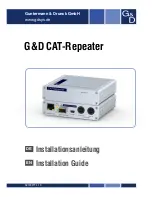
6
MONTAGE
INSTALLATION
Um eine optimale Luftzirkulation zu erreichen, sollte die Heizung im
unteren Bereich des Schaltschranks mit dem Anschluss / Lüfter nach
unten (Ausblasrichtung nach oben), oder zur Seite montiert werden.
Die Heizung kann über eine Halteklammer (35mm-Tragschiene nach
DIN EN 50 022) oder über Ösen für Schraubbefestigung montiert
werden.
Es ist ein Abstand zu benachbarten Geräten von 100 mm nach unten
(Ansaugrichtung) und 300 mm nach oben (Ausblasrichtung), sowie
ein seitlicher Abstand von mindestens 50 mm einzuhalten.
In order to achieve an optimum air circulation, the heater should be mounted in
the bottom section of the enclosure, with the cable entry / fan facing downward
(blowing side upwards) or to the side. The heater can be mounted via a retaining
clip (35 mm mounting rail to DIN EN 50 022) or via eyelets for screw fastening.
Keep a minimum distance of 100 mm downwards (sucking side) and 300mm
upwards (blowing side), as well a minimum distance from neighboring pieces of at
least 50 mm.
ELEKTRISCHER ANSCHLUSS
ELECTRIC INSTALLATION
Für den elektrischen Anschluss ist der Schaltschrank vorher vorschriftsmäßig außer
Betrieb zu nehmen. Die Spannungsversorgung ist an die Anschlussklemmen bzw.
Leitung anzuschließen. Dabei sind die zulässigen Anschlusswerte auf dem Typenschild zu beachten. Vor dem Anklemmen
der Zuleitung, muss der Deckel auf der Oberseite abgeschraubt werden. Die Zuleitung darf nicht über die Ausblasseite
erfolgen, da sonst eine übermäßige Erwärmung der Zuleitung möglich wäre.
Aufgrund der PTC-Charakteristik ist eine träge Vorsicherung erforderlich. Der Einschaltstrom kann bei 230 V kurzzeitig ein
bis zu 6-faches des Nennstromes betragen. Dies ist bei der Vorsicherung zu beachten.
Zur Regelung oder Überwachung der Heizungen können Thermostate und Hygrostaten, die als Zubehör lieferbar sind,
verwendet werden.
For the electrical connection, the control cabinet must first be disconnected. Connect the supply voltage to the terminal or
connection cable. The admissible connected load according to information on the type plate must be observed. Before
connecting the power connection, the top cover must be remove. The power connection should not pass closely to the
blowing side, because of warming up the wire.
Due to the PTC characteristics of the heaters a slow fuse is required. The inrush current at 230 V can be up to 6 times
higher than the rated current. This is to be considered with the backup fuse.
Thermostats and hygrostats, which are available as accessories, can be used to control or to monitor the heaters.



























